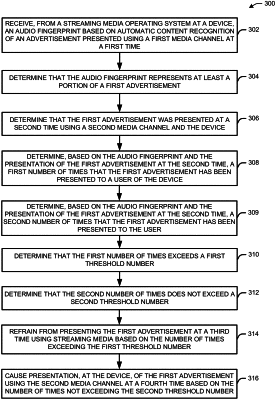| CPC H04N 21/454 (2013.01) [H04N 21/4394 (2013.01); H04N 21/44204 (2013.01)] | 20 Claims |

|
6. A method for managing advertisement exposure, the method comprising:
receiving, by at least one processor of a first device, from a streaming media operating system of a second device, an audio fingerprint based on presentation of first media content using a first media channel at a first time;
determining, by the at least one processor, using automatic content recognition, that the audio fingerprint represents at least a portion of a first advertisement;
determining, by the at least one processor, that the first advertisement was presented at a second time using a second media channel and the second device;
determining, by the at least one processor, based on the audio fingerprint and the presentation of the first advertisement at the second time, a first number of times that the first advertisement has been presented to a user of the second device, the first number of times associated with a third time;
determining, by the at least one processor, that the first number of times that the first advertisement has been presented to the user exceeds a first threshold number associated with the third time;
refraining, by the at least one processor, based on the first number of times exceeding the first threshold number, from selecting the first advertisement for subsequent presentation using the second media channel at the third time;
determining, by the at least one processor, based on the audio fingerprint and the presentation of the first advertisement at the second time, a second number of times that the first advertisement has been presented to a user of the second device, the second number of times associated with a fourth time;
determining, by the at least one processor, that the second number of times that the first advertisement has been presented to the user is below a second threshold number associated with the fourth time;
selecting, by the at least one processor, based on the second number of times being below the second threshold number, the first advertisement for subsequent presentation using the second media channel at the fourth time; and
causing presentation, by the at least one processor, at the second device, of the first advertisement using the second media channel at the fourth time.
|